
Michigan Stadium Press Box
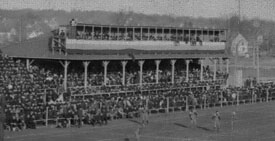
Ferry Field press gallery, added atop the
grandstand in 1903
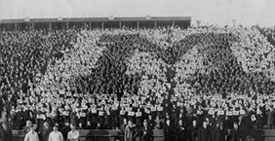
Press box at the top of north stands of the new
Ferry Field, 1906
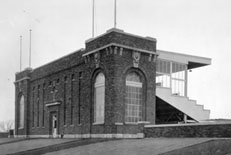
The new press box from the southwest, 1927
The Michigan Chronicle student reporter who covered the first home game played at the Ann Arbor Fairgrounds on May 12, 1883, got his story on the sidelines - mixing freely with the players, contestants in the field-day events and spectators who lined the edge of the playing field. It was not until 1903 that Michigan provided a designated area for the working press. In that year, a press gallery was constructed on the roof of the Regents/Ferry Field grandstand.
When the new Ferry Field opened in 1906, it included a large press box along the top of the north bleachers. The Michigan Daily reporter pronounced it to be a "substantial and well equipped structure." Though Fielding Yost forced Ty Tyson to by a ticket and make the first radio broadcast from a seat in the stands in 1924, the press box was later changed to accommodate broadcasters.
Reporters working the opening game of Michigan Stadium on October 1, 1927, had to put up with a few inconveniences in the not quite finished press box. By the October 21st, however, the state-of-the-art facility was ready for the throng of reporters who came to town for the dedication game with Ohio State. There was room for 240 members of the working press, each with a desk area equipped with floor outlets for heaters and lights.
The front of the press box was open to insure an unobstructed view but each desk had a small "windshield" to protect the reporters papers. There were three radio booths, two private telephone booths and ample facilities for the newsmen to wire in their stories
By the time Army came to town in 1946, a series of alterations had transformed the look of the press box. A third deck had been added, in part to better accommodate movie cameras, and the lower deck had been glassed in. Additional telephone lines had been installed and radio broadcasting booths were added.
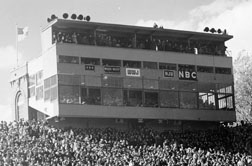
A full press box for the 1946 Army game
The powerhouse Army team led by Glen Davis and Felix "Doc" Blanchard attracted one of the largest press contingents ever to cover a Michigan game. In addition to the regular radio coverage from WWJ and WJR, the three national networks carried the game across the country. Red Barber and Jimmy Dolan worked the mikes for CBS, Bill Stern did the play-by-play for NBC and Harry Wismer was in the ABC booth.
Newsreel crews were on hand from Pathe, Movietone and Paramount to capture highlights for theatre audiences. Sports Information Director Les Etter estimated 300 people packed the press box. Along with a capacity crowd of 85,398, they watched a game Wolverine squad drop a hard fought 20-13 decision to a veteran Cadet squad that would narrowly miss a third consecutive national championship.
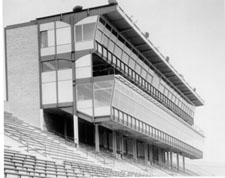
The state-of-the-art Communication
Center was completed as part of the
stadium expansion in 1956.
The original press box was replaced by a new Sports Communications Center in 1956. The new facility, with an exterior trim of blue brick, blue steel and yellow aluminum panels, included four levels and measured 186 feet long, stretching approximately between the 22 yard lines. The lower level housed the President's dining room and a complete kitchen suitable for entertaining guests of the university. The second level held the working press section with seats for 202 reporters in three rows, wire and telephone facilities and a speaker system to provide a running account of the game. A snack bar, staffed by student waiters served the sportswriters as well as the photographers and broadcasters overhead.
The third level served as the photographers deck with room for 38 still or newsreel cameras and a special section for television cameras. The fourth deck contained seventeen radio and television broadcast booths. The Communications Center included six photographic dark rooms enabling the newsmen to wire their photos directly from the stadium.
Newspaper reporters, radio and television technicians, and photographers who previewed and dedicated the Communications Center on September 22 judged it to be the most modern and fully equipped press box in the country. A week later, the opening game against UCLA brought Tom Harmon back to Michigan Stadium to call the game for the CBS Pacific Coast Regional Radio network. Curt Gowdy was in the NBC TV booth. Baseball immortal Leo Durocher served as the color commentator for a west coast television broadcast of the game.
The exterior appearance of the press box has undergone very little change since 1956, but the working areas have been upgraded a number of times. As newspapermen gave up their trusty Royals and Remingtons for PCs and Macs, the press box was refitted to accommodate them. Likewise, the radio and television booths have been upgraded to handle the latest technology.
From the first press gallery at Ferry Field to today's internet-ready facility, the Athletic Department has tried to accommodate the needs of the working press, even hiring one of the country's first full-time sports information director's in 1924. Still, the press box is just a facility, a place designed to help the men, and now women, who take the Wolverines' story to fans across the country to do their best work. And many of the country's great ones, from Walter Camp and Grantland Rice to Mel Allen, Keith Jackson and Michigan's own Tom Harmon, have filed stories or called the plays from Ferry Field and Michigan Stadium. A host of talented local reporters and photographers have also spent their careers covering the Wolverines. The Athletic Department has honored a number of them in the Media Hall of Fame located in the press box.
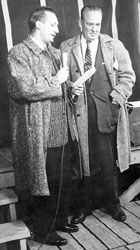
Lindsey Nelson and Red Grange
broadcasting from Michigan Stadium
in the 1940s
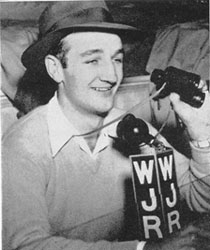
Tom Harmon got his start in radio while a
student, hosting a show on the campus
radio station. He teamed with Harry Wismer
to cover the Wolverines for WJR in 1941.
After the war and a stint in pro football he
hosted a nationally syndicated sports program.
top | previous | next
| Stadium Home Page | Ath. Dept. MGOBLUE |
Ath. History | Bentley Library

